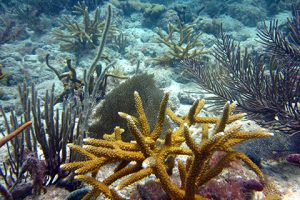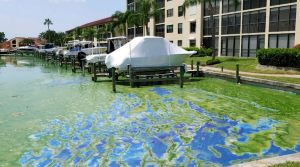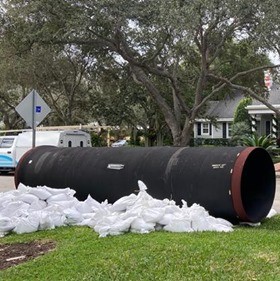Harmful algae blooms increasing
The summer heat wave that has set several electricity consumption records in Florida is also feared to be killing some coral in reefs in the Florida Keys, a new CDC report links sickness in humans and pets with algae blooms, and Miami is running out of space for its landfill and septic tank waste. It’s all in this week’s Environment & Engineering Digest.

Florida Coral. Courtesy, University of Miami Rosenstiel School of Marine, Atmospheric, and Earth Science
Heat & Coral Death: The recent 100-degree temperatures and up to 120-degree heat indexes is setting electricity consumption records around the state. All the major utilities report peak demand or have set new power consumption records this month. The heat has also caused record-setting surface sea temperatures approaching 100-degrees in the Gulf of Mexico off Florida’s west coast, as we referenced earlier in the newsletter. That has marine researchers worried.
The Associated Press reports that a team of researchers in the Florida Keys has been scrambling for most of this summer to rescue coral and put them in tanks where the water temperature never goes above 85-degrees compared to the Keys’ 91-degree average temps in mid-July. They are worried about bleaching, which causes coral to lose zooxanthellae, the algae that provides nourishment and color.
“We’re already seeing not just bleaching, but actual coral death out on the reef because the temperatures were so hot,” Cynthia Lewis, director of the Keys Marine Lab on Long Key, told the AP. Rescue groups have already brought more than 1,500 pieces of coral. “And we can’t afford to lose more of our reef,” she added.

Blue-green algae in a Florida waterway
CDC Algae Report: The U.S. Centers for Disease Control and Prevention (CDC) is out with a new report that says incidences of harmful algal blooms (HABs) are on the rise in the 16 states that voluntarily report cases (Florida is not one of them). No humans have died, but some animals have. The 2021 data shows there were 368 HABs reported that resulted in a total of 117 human illnesses and at least 2,715 animal illnesses. That’s a significant increase compared to the 250 HAB events reported in 2020 and 2019.
The CDC has said that exposure to high levels of blue-green algae and their toxins can cause illness and death. Most HAB events happen in the summer months when the water is warmest and 90% of them occur in freshwater bodies such as lakes and reservoirs. The most common signs and symptom in humans were gastrointestinal, generalized (such as headache and fever), and dermatologic (skin).

A new sewage main replacement pipe awaits installation in nearby Ft. Lauderdale, December 15, 2019
Miami-Dade’s Septic & Garbage Challenge: The Insurance Journal recently revisited Miami-Dade County’s decades-long struggle to convert more residents to public water and sewer systems and off of wells and septic tanks. It quotes Miami-Dade County Mayor Daniella Levine Cava as saying “It’s very critical. We have to address all of that aggressively.” The article notes that during heavy rains, some of the 108,000 septic tanks in the county overflow, spreading fecal bacteria. The county has spent about $1 billion on water and sewer lines in the past two years but getting everyone off of septic tanks is estimated to cost at least $4 billion.
Meanwhile, some of the county’s landfills will run out of space by 2026 and county law requires at least five years of garbage disposal capacity to avoid a building moratorium. Mayor Cava has proposed building a $1 billion incinerator and power plant to address the issue.
LMA Newsletter of 8-21-23

